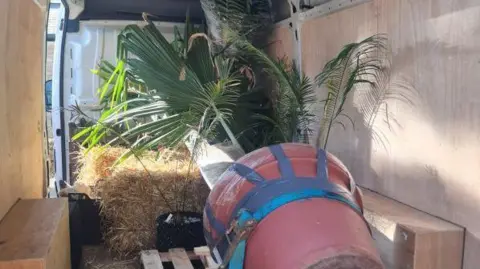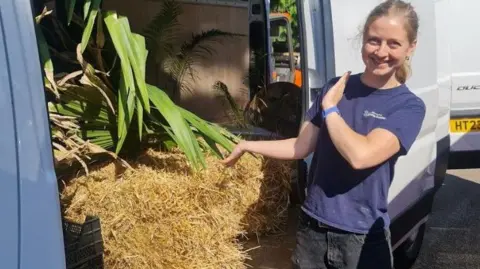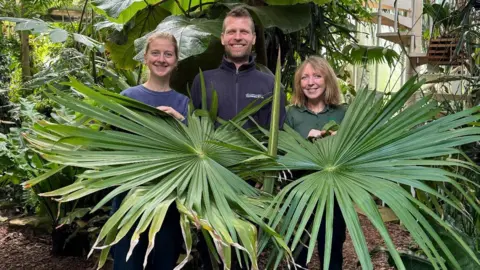Critically endangered plant makes 'daunting' move
 CUBG
CUBGTransporting one of the world's most endangered plants 340 miles (550km) across England was "a bit daunting", a horticulturalist admitted.
Staff recently did just that at Cambridge University Botanic Garden, when they took their 4m (13ft) tall Tahina spectabilis palm to the Eden Project in Cornwall.
There are only about 40 of these plants in the wild and they are listed as critically endangered.
The Cambridge specimen had reached the top of the glasshouse and had to be carefully wrapped and laid on hay bales for its seven-hour journey to the domed ecological visitor attraction near St Austell, where it stands a better chance of reaching its full potential - a massive 18m (59ft) high over its 50-year lifespan.
 CUBG
CUBGThe plant was first discovered in north-western Madagascar in 2006.
It is commonly known as the "suicide palm" or "self-destructive palm" for its unique lifecycle of flowering itself to death, staff at the Cambridge garden said.
"It is a monocarpic plant, meaning it flowers once in its lifetime before dying," they said.
"During this flowering event, the palm uses a huge amount of energy to produce a striking inflorescence of numerous small flowers, attracting birds and insects for pollination."
 CUBG
CUBGKathryn Bray, senior horticulturist at Cambridge University Botanic Garden, explained the specimen, which it acquired in 2009, had grown too big for its glasshouse, so it asked the Eden Project if it had room in its rainforest biome.
"They were delighted, because they had been wanting one for ages and this will be their first," said Ms Bray.
But getting it to Cornwall took months of careful planning, she said.
"We began thinking about the longevity of this plant in our glasshouse back in 2022 as it was growing so big.
"We had to re-pot it the following year as it had burst out of its original one."
In order to move the plant out of the glasshouse, staff from the university's landscape, machinery and estate teams were brought in to manoeuvre it on a pallet.
"The glasshouse is very narrow, with sharp angles," said Ms Bray.
"It took longer than we thought, as you're basically trying to figure out the logistics - this is the first time you've done it."
The palm was then forklifted into a van, where it was laid on hay bales and strapped into place.
 CUBG
CUBGMs Bray and colleague Barbara Griffith drove it to its destination, which took seven or eight hours.
"The traffic was awful and we also detoured to the University of Bristol Botanic Garden to pick up some other material," said Ms Bray.
"We had our palm all packed and strapped and resting on hay to stop it lolling about, but it was certainly a relief when we got it to Cornwall.
"It was all a bit daunting."
On the way back, they stopped at Kew Gardens in London and picked up a smaller Tahina spectabilis, which is now in the Cambridge glasshouse.
At about 1.5m (5ft) tall, this one should be able to happily grow for at least 10 years before it becomes too big, Ms Bray said.
Their original palm is now planted at the Eden Project, after being in quarantine for several weeks to check it was healthy.
It is now hoped it will be able to reach its full potential, displaying leaves with a diameter of 5m (16ft) before eventually flowering.
The move highlights the collaborative nature of botanic gardens worldwide, said Ms Bray.
"Global botanic gardens form a network which is hugely important to horticulture and conservation.
"Being able to donate a palm that is incredibly rare in the wild, to an institution where it can potentially reach flowering size, while receiving one better suited to Cambridge from a third garden, epitomises the importance of this network.
"We all have to work together to grow plants the best we can."
Follow Cambridgeshire news on BBC Sounds, Facebook, Instagram and X.
